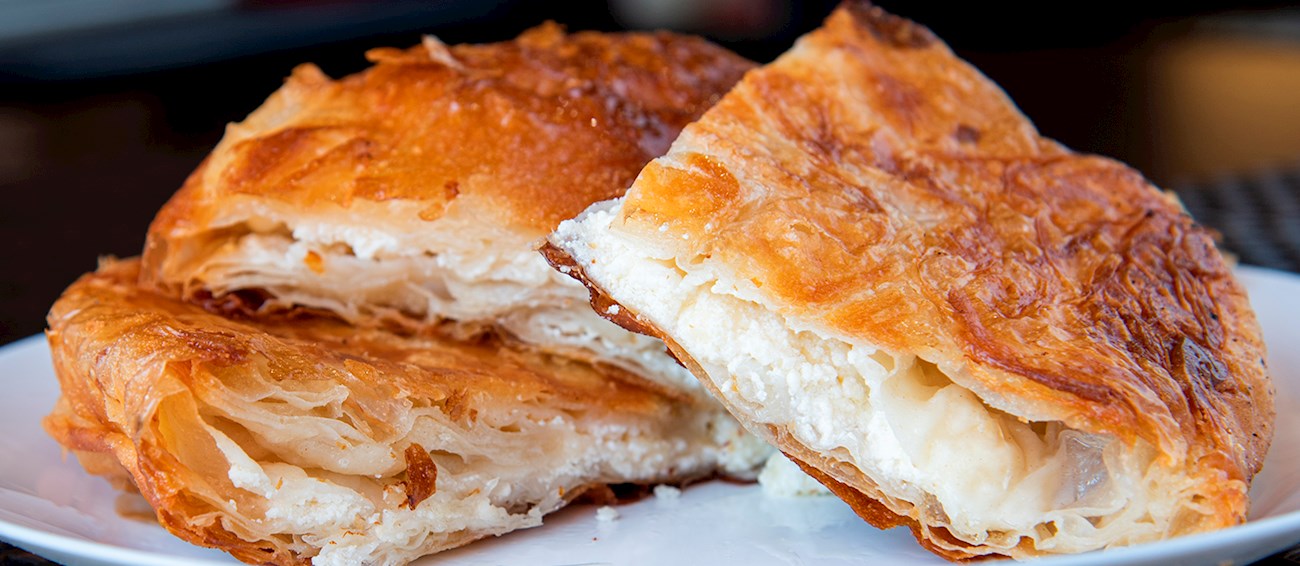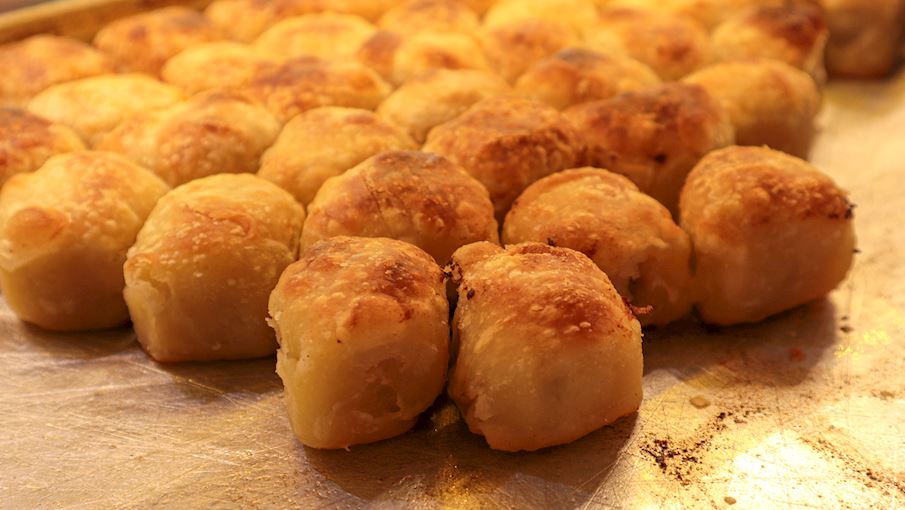Pazarske mantije is a Serbian dish originating from Novi Pazar. This dish resembles the Bosnian burek in flavor, but the shape is quite different – it's shaped into small spheres that are arranged in a baking pan and baked together.
The dough is first stretched, brushed with butter, then stuffed with ground beef, salt, pepper, onions, and a bit of oil. Once stuffed, the dough is shaped into small balls, arranged in a pan, then baked, traditionally in old furnaces which give them their unique flavor and aroma.
Mantije are usually accompanied by yogurt that's poured over them and eaten while still hot.
MAIN INGREDIENTS
Burek sa sirom is a phyllo pastry that is round or coil-shaped and filled with a mixture of cheese and eggs. The dough is made with flour, salt, and water (and perhaps a bit of oil) and stretched into translucent sheets. The sheets of phyllo dough are stacked in a large tray, and each sheet is sprinkled with oil or oil and mineral water and spread with the cheese and egg filling.
Still, you might have heard that burek can only be called burek if it's filled with meat. That is, if you live in Bosnia and Herzegovina, but not everyone does, nor is burek really Bosnian – in fact, it has Turkish origins. In Bosnia, burek (with meat) and other types of similar pies such as sirnica (cheese) and krumpiruša (potatoes) are usually rolled into a coil, while Croatians and Serbs have a more relaxed approach – burek can be round and cut into quarters, or rolled into a coil – both shapes are good, and both can be called burek sa sirom (when filled with cheese, of course).
Krapfen was probably the first European-style doughnut to appear, followed by similar varieties in other countries. These pastries are traditionally prepared with leavened dough that is deep-fried until golden and crispy on the outside, while they remain soft, light, and airy on the inside.
Though krapfen can be prepared plain, they are most often filled or topped with jams, and vanilla or chocolate custards, while the top is usually dusted with powdered sugar or drizzled with chocolate. The origin of the word krapfen dates back to 9th century, and the recipes in German can be found as early as the 14th century.
MAIN INGREDIENTS
Although it is a common sight in countries such as Croatia, Slovenia, and Macedonia, gibanica is mainly associated with Serbia. It is a traditional pie-like dish that combines phyllo dough (occasionally replaced with yeast dough) with a creamy combination of cheese and eggs.
The most popular version of this versatile pie is popularly known as gužvara, meaning crumpled, in which the sheets of phyllo dough are soaked in a creamy mixture of fresh cow’s cheese and eggs. The sheets are then layered and baked in the form of a casserole.
Bundevara is a flavorful Serbian pie consisting of phyllo sheets that are filled with grated pumpkin, sugar, and spices such as cinnamon or nutmeg. The pie can be additionally enriched by the addition of raisins. It can be served either hot or cold, and it is recommended to sprinkle it with powdered sugar on top before consumption.
Herovke are traditional sweet treats from Vojvodina, and they are especially popular in the region's Slovak community. They are made with flour, sugar, egg yolks, salt, sour cream, and rakija (local schnapps). The dough shouldn't be too hard nor too soft.
It is rolled thinly and cut into strips. The strips are rolled into small balls, and they are then placed inside a special tool (a long spoon with a rounded, pierced top part, which can be opened) before being deep-fried in hot oil until golden brown and crispy.
TasteAtlas food rankings are based on the ratings of the TasteAtlas audience, with a series of mechanisms that recognize real users and that ignore bot, nationalist or local patriotic ratings, and give additional value to the ratings of users that the system recognizes as knowledgeable. For the “Top 6 Serbian Pastries” list until March 21, 2025, 1,121 ratings were recorded, of which 797 were recognized by the system as legitimate. TasteAtlas Rankings should not be seen as the final global conclusion about food. Their purpose is to promote excellent local foods, instill pride in traditional dishes, and arouse curiosity about dishes you haven’t tried.





